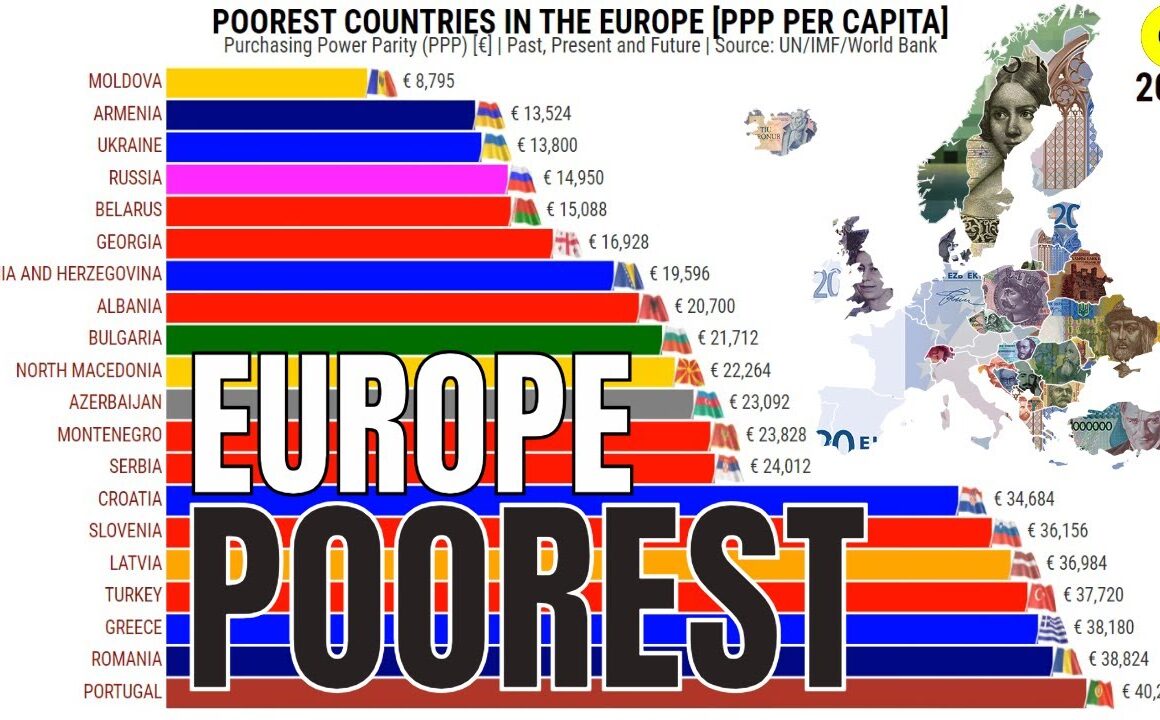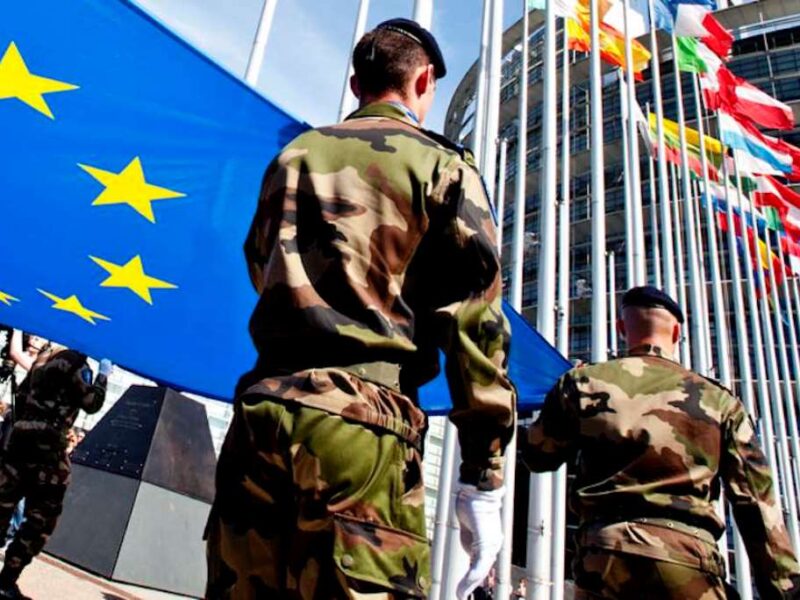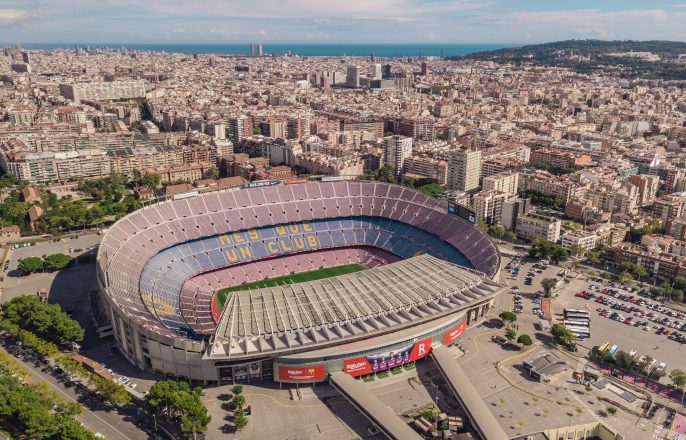Ever wondered why some corners of Europe feel worlds apart from the gleaming capitals of Paris or Berlin? As we gear up for 2026, the economic landscape across the continent tells a story of stark contrasts—booming tech hubs alongside regions still clawing their way out of post-communist shadows or war-torn recoveries. If you’re digging into the poorest countries in Europe, maybe for travel planning, economic studies, or just a dose of global awareness, this guide’s for you.
We’ll rank the top 10 by GDP per capita, chat about what makes their economies tick (or struggle), and highlight glimmers of hope amid the challenges. I’m no crystal ball gazer, but based on current trends, IMF projections, and on-the-ground vibes, here’s a snapshot of Europe’s economic underdogs in 2025. Let’s dive in with empathy and curiosity—because understanding poverty isn’t about pity; it’s about seeing the resilience that fuels comebacks.
Why Talk About Europe’s Poorest Nations in 2025?
Europe’s often painted as a monolith of prosperity, but scratch the surface, and you’ll find deep divides. The poorest countries in Europe this 2025 are mostly in the Balkans and Eastern fringes, grappling with legacies of conflict, brain drain, and sluggish integration into the EU. GDP per capita is our yardstick here—measuring average economic output per person—and it’s hovering low for these spots, often under $10,000 annually. Factors like corruption, outdated industries, and external shocks (hello, Ukraine’s war) keep them down, but EU funds, tourism booms, and young entrepreneurs are stirring change. For travelers or investors eyeing undervalued gems, knowing these dynamics uncovers authentic experiences and smart opportunities. From misty Moldovan vineyards to resilient Ukrainian markets, these nations aren’t just stats—they’re stories of grit. Onward to the list, starting with the toughest spots.
10 Poorest Countries in Europe in 2025 (by GDP per Capita)
| Rank | Country | GDP per Capita (Nominal, USD, 2025 est.) | GDP per Capita (PPP, USD, 2025 est.) | Capital | Currency | EU/Status |
|---|---|---|---|---|---|---|
| 1 | Ukraine | ~$5,200 | ~$16,000 | Kyiv | UAH | EU candidate |
| 2 | Kosovo | ~$6,700 | ~$15,500 | Pristina | EUR | EU potential candidate |
| 3 | Moldova | ~$6,800 | ~$19,000 | Chișinău | MDL | EU candidate |
| 4 | Albania | ~$7,400 | ~$18,500 | Tirana | ALL | EU candidate |
| 5 | North Macedonia | ~$8,000 | ~$21,000 | Skopje | MKD | EU candidate |
| 6 | Bosnia and Herzegovina | ~$8,300 | ~$22,000 | Sarajevo | BAM | EU candidate |
| 7 | Armenia | ~$8,700 | ~$22,500 | Yerevan | AMD | Council of Europe member |
| 8 | Georgia | ~$9,000 | ~$24,000 | Tbilisi | GEL | EU candidate |
| 9 | Belarus | ~$9,200 | ~$25,000 | Minsk | BYN | Non-EU |
| 10 | Montenegro | ~$10,700 | ~$28,000 | Podgorica | EUR | EU candidate |
10. Romania – Projected GDP per Capita: $16,500
Sliding into tenth on our poorest countries in Europe 2025 lineup is Romania, with a projected GDP per capita around $16,500. It’s the EU’s black sheep economically, but don’t let that fool you—this Black Sea giant has Dracula lore, wild Carpathian hikes, and a tech scene bubbling in Bucharest.
Romania’s woes stem from a rocky post-1989 transition: Heavy industry collapsed, leaving rust-belt towns, while corruption scandals erode trust. Yet, 2025 looks brighter with EU recovery funds pouring in for green energy and digital upgrades. Head to Transylvania for medieval festivals in Sibiu, or Bucharest’s edgy street art scene—it’s cheaper than you think, with a meal under $10. Fun twist: Romania’s the world’s second-largest IT outsourcing hub, exporting code to Silicon Valley. For budget backpackers hunting affordable Europe, it’s a steal—think thermal spas in Baile Herculane without the crowds. Romania’s proving that even among Europe’s struggling economies, cultural riches can outshine fiscal woes.
9. Montenegro – Projected GDP per Capita: $12,800
Ninth spot goes to Montenegro, clocking in at about $12,800 per capita in 2025 projections. This Adriatic sliver, independent since 2006, boasts yacht-dotted bays and Black Mountain trails, but its economy leans too hard on tourism—making it vulnerable to pandemics or recessions.
Post-Yugoslav scars linger: Unemployment hovers near 15%, and foreign debt piles up from flashy coastal developments. Still, EU candidacy talks could unlock billions in aid by 2025. Kotor’s fjord-like old town is a UNESCO stunner—wander its walls for sea views that heal the soul. Sample black risotto (squid ink pasta) in Budva, where nightlife rivals Ibiza on a shoestring. A quirky note: Montenegro uses the euro sans EU membership, a bold move that’s stabilized things. As one of the poorest countries in Europe, it’s a paradox—stunningly beautiful yet begging for sustainable growth. Eco-tourists, take note: Kayaking glacial lakes here feels like stealing paradise.
8. Bulgaria – Projected GDP per Capita: $11,200
At number eight, Bulgaria’s eyeing $11,200 per capita for 2025. The EU’s oldest member from the east, it’s got Black Sea beaches, Rose Valley perfumes, and ancient Thracian tombs, but inequality bites hard—rural poverty contrasts Sofia’s startup buzz.
Communism’s hangover includes creaky infrastructure and organized crime echoes, though Schengen entry in 2025 could turbocharge trade. Agriculture and manufacturing drag, but renewables are rising. Plovdiv’s Roman theater hosts summer operas—catch one with yogurt-based banitsa pastry for breakfast. Fun fact: Bulgaria invented the Cyrillic alphabet, and its wrestlers dominate Olympics. For those exploring Europe’s poorest economies, Bulgaria’s a gateway: Affordable ski resorts in Bansko draw Brits, blending value with Balkan warmth. It’s inching up, one EU grant at a time.
7. Serbia – Projected GDP per Capita: $10,900
Serbia claims seventh with a projected $10,900, a landlocked powerhouse of rakija toasts and Danube cruises. Belgrade’s fortress parties pulse with energy, but 1990s wars left scars—high youth unemployment and Kosovo tensions stifle investment.
2025 might see Chinese-backed rail projects boost exports, yet EU accession delays loom. Novi Sad’s EXIT festival is Europe’s edgiest—rave in a fortress for under $50. Try ćevapi (grilled sausages) from street carts; they’re soul food. Tidbit: Nikola Tesla was Serbian—visit his Belgrade museum for electrifying exhibits. Among the poorest countries in Europe 2025, Serbia’s got swagger: It’s the continent’s top plum brandy producer, fueling a resilient spirit. Road trippers, the Drina River border with Bosnia is poetic—raw history meets rebirth.
6. Albania – Projected GDP per Capita: $9,300
Midway through, Albania hits $9,300 per capita in forecasts. This Balkan enigma, with Ottoman bazaars and Riviera beaches, emerged from isolation in the ’90s, but pyramid schemes and emigration have hollowed out its workforce.
Tourism’s the lifeline—2025 projections see visitor numbers double, thanks to cheap flights from the UK. Tirana’s colorful facades hide bunker museums (Enver Hoxha built 170,000!). Hike the Accursed Mountains for eagle views, or chill in Saranda’s Ionian waters. Burek pastries fuel the day affordably. A neat nugget: Albania’s the world’s only country with more atheists than believers. As a poor European nation, it’s transforming—hydro power and cannabis legalization (medicinal) hint at green futures. Adventure seekers, it’s raw and rewarding.
5. North Macedonia – Projected GDP per Capita: $8,700
Fifth place for North Macedonia at $8,700, a name change in 2019 that eased Greece tensions but didn’t instantly fix factories shuttered since Yugoslavia. Ohrid Lake’s Byzantine churches shimmer like jewels, yet corruption indexes keep investors wary.
EU talks progress slowly, but 2025 could bring mining booms and agrotech. Skopje’s Alexander the Great statues spark debates—wander the old bazaar for Ottoman sweets. Tavče gravče (bean stew) warms winter nights. Fun fact: Mother Teresa hailed from here—her Skopje birthplace tugs heartstrings. In Europe’s poorest countries list, North Macedonia’s a cultural crossroads: Wine tours in Tikves rival Tuscany, minus the markup. It’s small but spirited, with hiking trails that whisper of ancient Illyrians.
4. Bosnia and Herzegovina – Projected GDP per Capita: $8,200
Number four is Bosnia and Herzegovina, projected at $8,200. War-ravaged in the ’90s, this tripartite state (Bosniak, Serb, Croat) stuns with Mostar’s arched bridge and Sarajevo’s Ottoman cafes, but ethnic divides stall reforms.
2025 might leverage EU candidacy for infrastructure cash, though remittances from expats prop up families. Sarajevo’s Tunnel of Hope museum is a poignant must—emerge stronger. Ćevapi here are legendary, grilled fresh. Tidbit: The 1984 Winter Olympics site in Jahorina offers budget slopes. Among struggling European economies, Bosnia’s resilience shines—street art in war-scarred buildings tells tales of unity. For reflective travelers, it’s profound: Bridge-jumping in Mostar symbolizes leaps forward.
3. Kosovo – Projected GDP per Capita: $6,500
Bronze for Kosovo at $6,500, Europe’s youngest nation since 2008. Pristina’s Newborn monument celebrates freedom, but disputed status hampers trade—Serbia blockades keep it landlocked in spirit.
Mining and diaspora money fuel 2025 growth, with EU visa liberalization easing brain drain. Rugova Canyon’s hikes rival the Alps, free and fierce. Qofte meatballs sizzle at markets. Fun fact: Kosovo’s rappers like Noisia put it on global maps. As one of the poorest countries in Europe 2025, it’s electric—Prizren’s Ottoman festival blends faiths in harmony. Photographers, the Prizren League tower is gold at dusk. Kosovo’s not just surviving; it’s remixing its future with youthful verve.
2. Ukraine – Projected GDP per Capita: $5,200
Silver medal amid heartbreak: Ukraine at $5,200, battered by Russia’s 2022 invasion but unbowed. Kyiv’s golden domes and Lviv’s coffee culture endure, though reconstruction costs trillions—war’s toll on agriculture and steel is brutal.
2025 Western aid could rebound exports, with IT sectors (Ukraine’s a top coder exporter) leading. Chernobyl tours offer eerie insights, or Odessa’s beaches for salty escapes. Borscht variations warm the soul. A poignant note: Sunflower fields symbolize resistance—drive the Golden Ring for blooms. In Europe’s poorest economies, Ukraine’s defiance inspires: Volunteer in Lviv’s aid hubs, witness humanity’s spark. It’s a nation rebuilding, one resilient harvest at a time.
1. Moldova – Projected GDP per Capita: $4,800
Topping our poorest countries in Europe 2025 is Moldova at $4,800—the continent’s true underbelly. Sandwiched between Ukraine and Romania, its Soviet vineyards and underground cellars hide poverty, with Transnistria’s frozen conflict siphoning energy.
EU association since 2014 brings slow wins, but 2025 remittances (25% of GDP) and wine exports offer hope. Chișinău’s central market buzzes with bargains—try mămăligă (polenta) with sour cherries. Orheiul Vechi’s cave monasteries stun. Tidbit: Moldova has Europe’s largest wine collection in Milestii Mici—1.5 million bottles! As the poorest European nation, it’s generous: Homestays in villages feel like family. Wine lovers, cellar tours beat Napa for intimacy. Moldova’s quiet revolution—against corruption, for unity—is worth rooting for.
Glints of Hope and Tips for Engaging with Europe’s Poorest
Beyond the top 10, nods to Belarus (stagnant under sanctions) or post-Brexit pressures on others. But here’s the uplift: EU enlargement could lift all boats by 2030, with green jobs and digital skills as lifelines. For travelers to these poorest countries in Europe 2025, go ethical—support local eateries, avoid all-inclusives. Budget tip: Ryanair to Sofia or Wizz to Tirana keeps costs low. Voluntourism in Ukraine or Moldova builds bridges. Economically, watch for fintech in Serbia or agrotech in Albania—they’re disruptors in disguise.
ALSO SEE: TOP 10 RICHEST COUNTRIES IN EUROPE
These nations aren’t defined by deficits; they’re tapestries of endurance, from Bosnian bridge-builders to Moldovan vintners. Poverty in Europe 2025 is a chapter, not the book—fueled by aid, innovation, and unbreakable spirit. It challenges us to look deeper, travel kinder, invest wiser.
Your Thoughts on Europe’s Poorest Countries?
Which of these poorest countries in Europe 2025 intrigues you most? Dreaming of Albanian beaches or Ukrainian sunflowers? Share in the comments—your stories fuel the conversation. If economic insights or offbeat travel hooks you, browse our posts on emerging EU markets or Balkan backpacking. Here’s to brighter horizons—cheers from this corner of the world.





